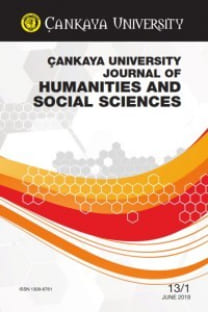Personality Measurement and Faking: An Integrative Framework
seçme, kişilik testi, yanıltmacılık, örtük kişilik ölçümleri
Personality Measurement and Faking: An Integrative Framework
personality testing, selection, faking, implicit personality measures,
___
- Asendorpf, Jens B., Banse, Rainer, and Mücke, Daniel, “Double Dissociation between Implicit and Explicit Personality Self-Concept: The Case of Shy Behavior,” Journal of Personality and Social Psychology, 83 (2002), pp.380-393. Costa, Paul and McCrae, Robert R., Revised NEO Personality Inventory (NEO-PI-R) Professional Manual, (Odessa, FL: Psychological Assessment Resources, 1992). Frost, Brian C., Ko, Chia-Huei E. and James, Lawrence R., “Implicit and Explicit Personality: A Test of Channeling Hypothesis for Aggressive Behavior,” Journal of Applied Psychology, 92/5 (2007), pp.1299-1319. Greenwald, Anthony G., McGhee, Debbie E. and Schwartz, Jordan L. K., “Measuring Individual Differences in Implicit Cognition: The Implicit Association Test,” Journal of Personality and Social Psychology, 74 (1998), pp.1464-1480. Hogan, Joyce, Barrett, Paul and Hogan, Robert, “Personality Measurement, Faking and Employment Selection,” Journal of Applied Psychology, 92/5 (2007), pp.1270-1285. James, Lawrence R., “Measurement of Personality via Conditional Reasoning,” Organizational Research Methods, 1 (1998), pp.131-163. LeBreton, James M., Barksdale, Cheryl D., Robin, Jennifer and James, Lawrence R., “Measurement Issues Associated with Conditional Reasoning Tests: Indirect Measurement and Test Faking,” Journal of Applied Psychology, 92/1 (2007), pp.1-16. McDaniel, Max J., Beier, Margaret E., Perkins, Andrew W., Goggin, Stephen and Frankel, Brian, “An Assessment of the Fakeability of Self-Report and Implicit Personality,” Journal of Research in Personality, 43/4 (2009), pp.682-685. Morgeson, Frederick P., Campion, Michael A., Dipboye, Rorbert L., Hollenbeck, John R., Murphy, Kevin and Schmitt, Neal, “Are We Getting Fooled Again? Coming to Terms with Limitations in the Use of Personality Tests for Personnel Selection,” Personnel Psychology, 60/4 (2007), pp.1029-1049. Ones, Deniz S., Dilchert, Stephan, Viswesvaran, Chockalingam and Judge, Timothy A., “In Support of Assessment of Personality in Organizational Settings,” Personnel Psychology, 60 (2007), pp.995-1027. Paulhus, Delroy L., Balanced Inventory of Desirable Responding (BIDR) Reference Manual for Version 6, (Manual available from author at Department of Psychology, University of British Columbia, Vancouver, B. C., Canada, V6T IY7, 1991). Rosse, Joseph G., Stecher, Mary D., Miller, Janice L. and Levin, Robert A., “The Impact of Response Distortion on Pre-Employment Personality Testing and Hiring Decisions,” Journal of Applied Psychology, 83 (1998), pp.634-644. Schnabel, Konrad, Banse, Rainer and Asendorpf, Jens, “Employing Automatic Approach and Avoidance Tendencies for the Assessment of Implicit Personality Self-Concept: The Implicit Association Procedure (IAP),” Experimental Psychology, 53/1 (2006), pp.69-76. Siers, Brian P. and Christiansen, Neil D., “On the Validity of Implicit Association Measures of Personality Traits,” Personality and Individual Differences, 54/3 (2013), pp.361-366. Tett, Robert P. and Christiansen, Neil D., “Personality Tests at the Crossroads: A Response to Morgeson, Campion, Dipboye, Hollenbeck, Murphy and Schmitt,” Personnel Psychology, 60 (2007), pp.967-993.
- ISSN: 1309-6761
- Yayın Aralığı: Yılda 2 Sayı
- Başlangıç: 2004
- Yayıncı: Çankaya Üniversitesi
TAMAR SHARON, Human Nature in an Age of Biotechnology: The Case for Mediated Posthumanism
Images of Children in Ian McEwan’s The Cement Garden and William Golding’s Lord of the Flies
Victorian Scripts, Nostalgic Traces and Romance in Michèle Roberts’ Fiction
The Anticipatory Corpse: Medicine, Power, and the Care of the Dying
Personality Measurement and Faking: An Integrative Framework
Sosyal Demokrasinin ‹skandinavya’daki ‹zdüflümü: Ak›nc› Vikinglerden Uzlafl› Kültürüne Geçifl
JEFFREY BISHOP, The Anticipatory Corpse: Medicine, Power, and the Care of the Dying
Rationalization in Weber and Habermas: A Comparative Perspective on a Macrosociological Concept
Kehinde: Floundering between Two Opposite Worlds
TEMMUZ-ARALIK 2013 ARASI TÜRKİYE’DE YAYINLANAN YENi KiTAPLARDAN SEÇMELER
Çankaya University JOURNAL OF HUMANİTİES AND SOCİAL SCİENCES
